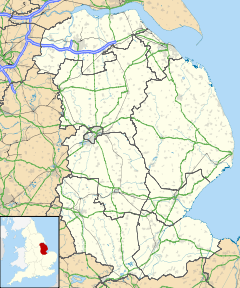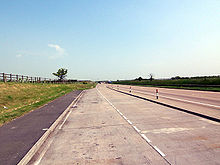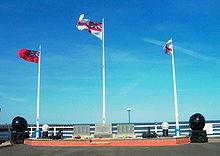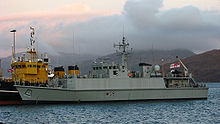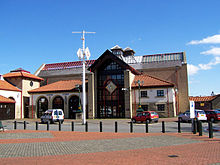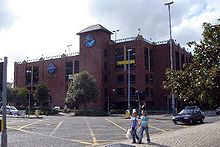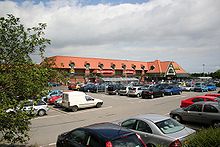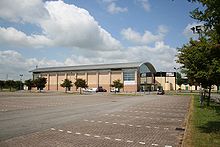- Grimsby
-
For other uses, see Grimsby (disambiguation).
Coordinates: 53°33′34″N 0°04′05″W / 53.5595°N 0.0680°W
Grimsby 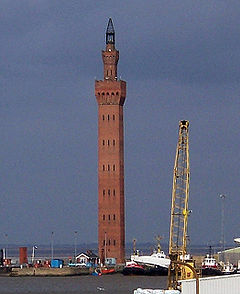
Grimsby Dock Tower
 Grimsby shown within Lincolnshire
Grimsby shown within LincolnshirePopulation 87,574 OS grid reference TA279087 Unitary authority North East Lincolnshire Ceremonial county Lincolnshire Region Yorkshire and the Humber Country England Sovereign state United Kingdom Post town GRIMSBY Postcode district DN31 - DN34, DN35, DN37 Dialling code 01472 Police Humberside Fire Humberside Ambulance East Midlands EU Parliament Yorkshire and the Humber UK Parliament Great Grimsby List of places: UK • England • Lincolnshire Grimsby (or archaically Great Grimsby) is a seaport on the Humber Estuary in Lincolnshire, England. It has been the administrative centre of the unitary authority area of North East Lincolnshire since 1996. According to legend, Grimsby was first founded by Grim, a Danish fisherman,[1] 'By' means 'village' in Old Norse and 'city' or 'town' in the modern Danish language and Norwegian language.
Contents
Geography
The town was previously titled "Great Grimsby" to distinguish it from Little Grimsby, a village about 14 miles (22 km) to the south, near Louth. People from Grimsby are called Grimbarians.[2]
The town itself has a population of 87,574.[3] It is physically linked to the adjoining town of Cleethorpes, and 11,000 of its inhabitants live in the village of Scartho which was absorbed into Grimsby before laws on the green belt were put in place. All three areas come under the jurisdiction of the same council, North East Lincolnshire. It is close to the main terminus of the A180, which ends in Cleethorpes. 22 January is Great Grimsby Day.[4]
The River Freshney passes to the west of the town, towards the A46. The A46 terminates near Grimsby in Cleethorpes at the junction with the A16 just north of Oasis Academy Wintringham.
History
Vikings
Grimsby was founded by the Danes in the 9th century AD, although there is some evidence of a small town of Roman workers sited in the area some seven centuries earlier. Located on The Haven, which flowed into the Humber, Grimsby would have provided an ideal location for ships to shelter from approaching storms. It was also well situated for the rich fishing grounds in the North Sea.
The name Grimsby probably originated from the Grim's by, or "Grim's Village". This is based on Grim the Danish Viking, supposedly the founder of the town, with the suffix -by being the Old Norse word for village. For more on the legendary founding of Grimsby see the Lay of Havelock the Dane. This is only one explanation of the founding of Grimsby, and is completely unsupported, being a legend. There is however a Grim and Havelock Association which has produced evidence to back up the legend.
In Norse Mythology, 'Grim' (Mask) and 'Grimnir' (Masked One) are names adopted by the deity Odin (Anglo-Saxon 'Woden') when traveling incognito amongst mortals, as in the short poem known as 'Grimnir's Sayings' (Grimnismal) in the Poetic Edda,[5] so the intended audience of the Havelock tale (recorded much later in the form of The Lay of Havelock the Dane) may have implicitly understood the fisherman Grim to be Odin in disguise. The Odinic name 'Grimr/Grim' occurs in many English placenames within the historical Danelaw and elsewhere in Britain, examples being the numerous earthworks named Grimsdyke.[6] Every other British placename containing the element Grim- is explained as a reference to Woden/Odin (e.g. Grimsbury, Grimspound, Grime's Graves, Grimsditch, Grimsworne), so one may argue that 'Grimsby' is unlikely to have a different derivation.
Grimsby is listed in the Domesday Book, having a population of around 200, a priest, a mill and a ferry (probably to take people across the Humber, to Hull).
It also appears in the Orkneyinga Saga in this Dróttkvætt stanza by the Viking Rǫgnvald Kali:
- Vér hǫfum vaðnar leirur vikur fimm megingrimmar;
- saurs vara vant, er várum, viðr, í Grímsbœ miðjum.
- Nú'r þat's más of mýrar meginkátliga látum
- branda elg á bylgjur Bjǫrgynjar til dynja.
- "We have waded in mire for five terrible weeks; there was no lack of mud where we were, in the middle of Grimsby. But now away we let our beaked moose [= ship] resound meerily on the waves over the seagull's swamp [= sea] to Bergen."
During the 12th century, Grimsby developed into a fishing and trading port, at one point ranking twelfth in importance to the Crown in terms of tax revenue. The town was granted its charter by King John in 1201 The first mayor was installed in 1218.
Grimsby does not have town walls. It was too small and was protected by the marshy land around it. However, the town did have a ditch. In medieval times, Grimsby had two parish churches, St Mary's and St James'. Only St James', now known as Grimsby Minster, remains. St James' shares with Lincoln Cathedral the folk tale of an Imp who played tricks in the church and was turned into stone by an angel (see Lincoln Imp).
In the 15th century, The Haven began to silt up, preventing ships in the Humber from docking. As a result, Grimsby entered a long period of decline which lasted until the late 18th century. In 1801, the population of Grimsby numbered 1,524[citation needed], around the same size that it had been in the Middle Ages.
Fishing and maritime industry
In the early 19th century, the town grew rapidly. The Great Grimsby Haven Company was formed by Act of Parliament in May 1796 (the Grimsby Haven Act) for the purpose of "widening, deepening, enlarging, altering and improving the Haven of the Town and Port of Great Grimsby". Grimsby's port boomed, importing iron, timber, wheat, hemp and flax. New docks were necessary to cope with the expansion. The Grimsby Docks Act of 1845 allowed the necessary building works.
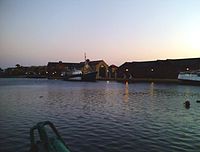 Alexandra Docks and National Fishing Heritage Centre
Alexandra Docks and National Fishing Heritage Centre
The Dock Tower was completed in 1851, followed by The Royal Dock in 1852. No.1 Fish Dock was completed in 1856, followed by No.2 Fish Dock in 1877. Alexandra Dock and Union Dock followed in 1879. During this period the fishing fleet was greatly expanded. In a rare reversal of the usual trends, large numbers of fishermen from the South-East and Devon travelled North to join the Grimsby fleet. Over 40% of these newcomers came from Barking in East London, and other Thames-side towns.[7]
The arrival of the railway in 1848 made it far easier to transport goods to and from the port. Coal mined in the South Yorkshire coal fields was brought by rail and exported through Grimsby. Rail links direct to London and the Billingsgate Fish Market allowed for fresh 'Grimsby Fish' to gain renown nationwide. The demand for fish in Grimsby grew to such an extent that, at its peak in the 1950s, Grimsby laid claim to the title of 'the largest fishing port in the world'.[8] Following the pressures placed on the industry during the Cod Wars, many Grimsby firms made the decision to cease trawling operations from the town. The sudden demise of the Grimsby fishing industry brought to an end a way of life and community that had existed for generations. Huge numbers of men were now made redundant, highly skilled in a job that did not exist, and facing the daunting prospect of finding work ashore; a complete change of life for a Grimsby trawlerman. The change in events, as seen in the case of Ross Group, allowed some firms to concentrate on other expanding industries within the town, such as food processing. Grimsby's trawling days are remembered through the artifacts and permanent exhibits seen at the town's Fishing Heritage Centre where the preserved 1950s trawler, Ross Tiger, is also to be found. Very few fishing vessels still operate from Grimsby's once thriving docks, although the town does maintain a substantial fish market, 'recognised as being one of the most important fish markets in Europe'.[9]
The population of Grimsby grew from 75,000 in 1901 to 92,000 by 1931 but then remained fairly static for the rest of the 20th century.[10]
The former Humber ferry, PS Lincoln Castle, moored was, since the mid-1980s, moored in Alexandra Dock. She was used during this time as a pub\restaurant, but despite the uniqueness of her design and status as Britain's last coal fired paddle steamer at the time of her withdrawal,[11] she was controversially broken up in 2010. Remaining berthed in the Alexandra Dock is the Ross Tiger, the last survivor of what was once the world's largest sidewinder trawler fleet,[12] which can be toured throughout the year as part of the Fishing Heritage centre.
World War II
During World War II, Grimsby's status as a major port made it a focus of the German Luftwaffe.[citation needed] They used the Dock Tower as a landmark and refused to bomb it (the British Government discussed its demolition to prevent its use as a navigational aid).[citation needed] It was later revealed that had the German invasion been successful Grimsby would have been one of the first landing points in the north of England due to the combination of its location and its infrastructure.[citation needed] This was probably one reason why the town suffered significantly less bombing raids than neighbouring fishing port Hull whose geographical location would have made it harder to reach. However, Grimsby was still hit by numerous air raids during the war and 197 people were killed. Grimsby was also the first place in Great Britain to have the Butterfly Bomb used against it by the Luftwaffe in 1943, devastating many areas[citation needed].
The Royal Dock was used as the UK's largest base for minesweepers, to patrol the North Sea. Minesweepers are military vessels using deep-sea trawling methods. There is a memorial, financed and realised though the efforts of the Royal Naval Patrol Service Veterans, situated by the Queen's Steps at the lock pits and in the shadow of the Dock Tower. Grimsby class sloops saw service from the 1930s until 1966.
In reference to modern-day minesweeping, HMS Grimsby is a Sandown class minehunter (commissioned in 1999) currently in service in the Royal Navy.
Local government
Great Grimsby 
Great Grimsby as a Borough of HumbersideGeography Status Town Charter Granted 1201
Municipal Borough (1835-1889)
County Borough (1889-1974)
Borough (1974-1996)1911 area 2,868 acres (11.61 km2) 1961 area 5,881 acres (23.80 km2) HQ Grimsby History Created 1835 Abolished 1996 Succeeded by North East Lincolnshire 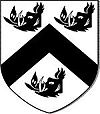
Arms of Great Grimsby Borough CouncilGreat Grimsby formed an ancient Borough in the North Riding of Lincolnshire, Parts of Lindsey.[13] It was reformed by the Municipal Corporations Act 1835 and became a Municipal Borough in that year.[14] In 1889 a County Council was created for Lindsey, but Great Grimsby was outside its area of control and formed an independent County Borough in 1891.[14] The Borough expanded to absorb the adjacent hamlet of Wellow (1889), also the neighbouring parishes of Clee-with-Weelsby (1889), Little Coates (1928), Scartho (1928), Weelsby (1928) and Great Coates (1968). It had its own police force until 1967 when it merged with the Lincolnshire force.[15]
In 1974, the County Borough was abolished[14] and Great Grimsby was reconstituted (with the same boundaries) as the Grimsby non-metropolitan district in the new county of Humberside by the Local Government Act 1972. The district was renamed Great Grimsby in 1979. Local government in the area came under the review of the Local Government Commission for England and Humberside was abolished in 1996. The former area of the Great Grimsby district merged with that of Cleethorpes to form the unitary authority of North East Lincolnshire.[16] The town does not have its own town council, instead there is a board of Charter Trustees. During 2007, in the struggle for identity, it was suggested that the district could be renamed to something like Great Grimsby and Cleethorpes to give a stronger indication of the towns the district consists of. This did not meet with favourable comment among local residents, and the Council Leader dropped the idea a year later.[17]
Council Wards and Elected Members
North East Lincolnshire Council has eight Council Wards within the area of Grimsby.
Freshney Ward
- Cllr Peggy Elliott (L)
- Cllr Clifford Barber (L)
- Cllr Ray Sutton (L)
Heneage Ward
- Cllr Rosalind A James (L)
- Cllr Matthew Patrick (L)
- Cllr Karl Wilson (L)
Scartho Ward
- Cllr Alex Baxter (C)
- Cllr Pat Colebrook (C)
- Cllr David J Hornby (C)
South Ward
- Cllr Jane Bramley (L)
- Cllr Norma Lincoln (L)
- Cllr Susan Pickett (C)
East Marsh Ward
- Cllr Stephen Beasant (LD)
- Cllr Jon-Paul Howarth (L)
- Cllr Terry Walker (L)
Park Ward
- Cllr Andrew De Freitas (LD)
- Cllr Christina McGilligan-Fell (LD)
- Cllr Geoff Lowis (LD)
West Marsh Ward
- Cllr Darren Billard (L)
- Cllr Ian Lindley (L)
Yarborough Ward
- Cllr Peter Wheatley (L)
- Cllr Peter K Bailey (LD)
- Cllr Anne Darby (LD)
KEY: (L) = Labour Party (C) = Conservative Party (LD) = Liberal Democrat Party
Economy
See also: Greater GrimsbyGrimsby, Immingham and Cleethorpes, together form the economic area known as Greater Grimsby.[18] The main sectors of the Greater Grimsby economy are food and drink; ports and logistics; renewable energy; chemicals and process industries and digital media.
Food industry
Grimsby is indelibly linked with the sea fishing industry, which once gave the town much of its wealth. At its peak in the 1950s, it was the largest and busiest fishing port in the world.[19] However as a result of the Cod Wars with Iceland this industry has been in decline for many years. It is still home to the largest fish market in the UK although most of what is sold is now brought overland from other ports or Iceland via containerisation.
Today, Greater Grimsby is home to around 500 food-related companies making it one of the largest concentrations of food manufacturing, research, storage and distribution in Europe. As a result the local council has promoted the town as Europe's Food Town for nearly twenty years.[20]
Grimsby is recognised as the main centre of the UK fish processing industry. In recent years, this expertise has led to diversification into all forms of frozen and chilled foods and consequently the town is one of the single largest centres of fish processing in Europe. More than 100 local companies are involved in fresh and frozen fish production, the largest of which is the Findus Group, comprising Young's Seafoods and Findus and whose corporate headquarters are in the town. Young's is a major employer in the area, with some 2,500 people based at its headquarters. From this base, Young’s has a global sourcing operation supplying 60 species from 30 countries.[21]
Media interest has surrounded Traditional Grimsby smoked fish, which was awarded a Protected Geographical Indication (PGI) by the European Union. This award safeguards the unique and specialist process of traditional fish smoking developed in the town. The traditional process relies on a natural method of slow smoking as opposed to the more widely used mechanical method. Producers that wish to call their product Traditional Grimsby smoked fish must adhere to strict quality standards laid down by the Grimsby Traditional Fish Smokers Group. As a regional food it has been commended by celebrity chefs Rick Stein, Mitch Tonks and Minister for Food and the Environment Jim Fitzpatrick in 2010.[22]
Other major seafood companies include the Icelandic-owned Coldwater Seafood,[23] employing more than 700 people across its sites in Grimsby and Five Star Fish,[24] a supplier of fish products to the UK foodservice market. The £5.6 million Humber Seafood Institute[25] opened in 2008 and is the first of its kind in the UK. Backed by Yorkshire Forward, North East Lincolnshire Council and the European Regional Development Fund, the HSI is managed by the local council and tenants include the Seafish Industry Authority and Grimsby Institute of Further & Higher Education. Greater Grimsby is a European centre of excellence in the production of chilled prepared meals, and the area has the largest concentration of cold storage facilities in Europe.[26]
The food production and seafood heritage links are perpetuated in a UK 2006 Young's television advertising campaign emphasising Grimsby as the source of its seafood products. In the campaign, Grimsby Docks are briefly shown, at dusk, lit and shot somewhat romantically. In 2008 this was followed up by further commercials paying reference to the town and its main industry as the company launched a range of Great Grimsby fish-based frozen meals.
Ports
The Port of Grimsby and Immingham is the UK’s largest port by tonnage.[27] Its prime deep-water location on the Humber Estuary, gives companies direct access to mainland Europe and beyond. Benefiting from a prime deep-water location on the Humber Estuary, one of Europe’s busiest trade routes, it plays a central role in the commercial life of the UK. The port is operated by Associated British Ports (ABP), the UK's largest and leading ports group. Grimsby and Immingham, and ABP's 19 other ports, form a UK-wide network capable of handling every conceivable type of cargo.
Flood sirens
The Environment Agency has awarded Sheffield-based telemetry company CSE Seprol a contract to supply flood warning devices for risk areas in East Anglia. CSE Seprol provides outstations that control the risk area's flood warning sirens to alert local people of impending severe flooding. The control and monitoring of the sirens is linked by a Seprol S250 telemetry outstation to the Environment Agency's Regional telemetry system.
The 18 sirens, at various locations around the flood risk area of Grimsby and Cleethorpes, should reach 25,500 households to warn them of portending floods. The sirens will only be sounded in the event of the Environment Agency issuing a severe flood warning for tidal flooding or if there is a likelihood of the sea defences being breached. The sirens make a variety of sounds, from the traditional wailing sound to a voice message. The alarms are said to sound like World War II air raid sirens, with an 'all clear' system in place.
In the event of flood siren activation, which can give up to six hours notice of pending floods, residents are advised to go indoors and listen to local radio stations BBC Radio Humberside or Viking FM.
Testing of the sirens takes place annually on 26 October, and residents are not required to take any action.
Places of interest and landmarks
- Corporation Bridge
- Fisherman's Memorial
- Freshney Place Shopping Centre
- Grimsby Docks
- Grimsby Dock Tower
- Grimsby Institute
- Grimsby Marina
- Grimsby Parish Church
- Grimsby Town Hall
- Humber Forts
- National Fishing Heritage Centre
- People's Park and Floral Hall
- Waltham Windmill
- Weelsby Woods
- Welholme Galleries
- Grimsby is the site of a Blue Cross Animal Hospital, one of only four in the country, the other three being situated in London. The Grimsby hospital was previously in Cleethorpe Road, but in 2005 it moved to a new building called 'Coco Markus House' in the town's Nelson Street.
Education
Infant, Junior & Primary schools
- East Ravendale CofE Primary School
- Edward Heneage Primary School
- Enfield Primary School
- Fairfield Primary School
- Grange Infant School and Nursery
- Grange Junior School
- Great Coates Primary School
- Humberston Cloverfields Primary School
- Humberston CofE Primary School
- Laceby Acres Primary School
- Lisle Marsden CofE Primary School
- Littlecoates Primary School
- Macaulay Primary School
- New Waltham Primary School
- Nunsthorpe Primary School
- Old Clee Primary School
- Scartho Infants School
- Scartho Junior School
- South Parade Primary School
- Springfield Primary School
- Strand Community School
- St. James' School
- St. Martin's Preparatory
- St. Mary's Catholic Primary School
- Stallingborough Primary School
- Stanford Junior and Infants School
- The Leas Infants School
- The Leas Junior School
- Weelsby Primary School
- Welholme Infants School
- Welholme Junior School
- Western Primary School
- Willows Primary School
- Woodlands Primary School
- Wybers Wood Primary School
- Yarborough Primary School
Secondary schools
- Havelock Academy
- Hereford Technology School
- Humberston Maths and Computing College
- Oasis Academy Wintringham
- St. James' School
- Western Technology School
- Tollbar Academy
- Whitgift School
Shopping facilities
The award-winning Freshney Place Shopping Centre[28] in the heart of the town boasts over 70 stores including Marks and Spencer, House of Fraser and BHS. It was originally constructed between 1967 and 1971 in a joint venture between the old Grimsby Borough Council and developers Hammerson's UK Ltd. and was known as the Riverhead Centre (so named as the development was adjacent to where the two local rivers, the Freshney and the Haven, meet). Victoria Street is the main shopping street.
The Riverhead Centre development caused some controversy at the time as it followed the 1960s trend of replacing old architecture with new; in this case it involved the wholesale demolition of much of the old town centre including the historic Bull Ring (which is now where Wilkinson's, the Halifax Bank and the St James Hotel are based) and streets going back many centuries including Flottergate (located at the present day entrance to Freshney Place between British Home Stores and the market), Brewery Street (located at the present day entrance to Freshney Place between the branch of Barclays Bank and the offices of the Cheltenham and Gloucester) and East St Mary's Gate (no trace remains). During this reconstruction the ornate Victorian branch of the Midland Bank was demolished and rebuilt into a contemporary design that was incorporated into the new shopping centre. In 1985 Marks and Spencer purchased the local department store Lawsons and Stockdale whose frontage ran along Victoria Street; like the Midland branch this was demolished and a new store, linked to the centre, was constructed.
In 1990 the council agreed to sell the area around the shopping centre, used for surface car parking, to Hammerson's UK Ltd. The development owner and Humberside County Council, the highway authority at that time, agreed to the sale of the area of Baxtergate, the road which ran to the rear of the shopping centre, between the shopping centre and the surface car park. Baxtergate was relocated alongside the River Freshney and became phase one of the Peaks Parkway. Hammerson's UK Ltd began a £100 million redevelopment of the site which saw it double in size. The centre was also covered in a glass roof and (where the new extension was built) two multi-storey car parks were constructed at each end of the centre, effectively privatising, roofing and enclosing the old Top Town area of Grimsby. Servicing to the stores was made available from a first floor service area, accessible even by large vehicles, using a ramp at the western end. The ramp also provided access to the car park on the roof of the indoor market which is operated by the local council. In recognition of the design of the new facilities, the Royal Town Planning Institute awarded the scheme a commendation in 1992.
Other developments near the town centre include a new Tesco Extra (the second in the area), the Victoria Mills Retail Park which is home to several chain stores including Next and a B&Q Depot off the Peaks Parkway A16.
Unlike many other towns that have shopping facilities on their outskirts, these (and other similar developments) can be found in and around Grimsby's town centre, making shopping far easier for pedestrians and public transport users, reflecting Grimsby's relatively cheap central commercial land. Other major retailers include the supermarket chains Tesco, Marks & Spencers, Sainsbury's, Asda on Holles Street and Morrisons. The Morrisons store is located just outside the town boundary, in the parish of Laceby, and is peculiarly known as Morrisons Cleethorpes. This is an anomaly arising from when the area was part of the now defunct Cleethorpes Borough. Most major supermarkets in the town have expanded somewhat in the last few years, including a massive extension built at Asda, and more recently another floor was built at Tesco at Hewitts Circus (although this store is technically in the neighbouring conurbation, Cleethorpes).
There are also a number of local, independent specialist stores and the Abbeygate Centre (off Bethlehem Street) is where many are located. Once the head office of local brewers Hewitt Brothers it was renovated in the mid-1980s and is home to a number of restaurants and designer clothing stores. The town also has two markets, one next to Freshney Place and the other in Freeman Street (B1213), itself once a dominant shopping area in the town with close connections to the docks but one that has sadly struggled since the late 1970s.
In March 2007, Henry Boot properties announced a new £30m shopping development adjacent to the existing Freshney Place site. The project will create 150,000 square feet (14,000 m2) of retail space and 290 car parking places on land between the River Freshney and Sainsbury's, presently occupied by the former Travis Perkins builders' merchants. As of November 2011 no work has commenced on the proposed development.
A further retail development is planned alongside the planned new stadium for Grimsby Town FC at Great Coates adjacent to the A180, scheduled for completion in mid-2010. As of November 2011 no work has commenced on the proposed development.
Such is the quality of shopping in the area that bus services are run to bring in shoppers from across the county of Lincolnshire, especially from smaller towns such as Louth,[29] Brigg, and Scunthorpe.[30]
Entertainment
The area has a developed, if somewhat corporate, nightlife. Aside from the nightclubs in nearby Cleethorpes, the town centre has undergone a renaissance in the last decade. A number of national pub chains have redeveloped or opened new outlets, including a specially-built complex at the Riverhead which is home to three (originally five) such operations. Prior to the late 1960s many public houses in the area were owned by the local brewer Hewitt Brothers and gave a distinctive local touch but following a takeover in 1969 by the brewer Bass Charrington these have been re-badged (many times), closed or sold off; examples are the Yarborough Hotel.
Musical entertainment is found at the Grimsby Auditorium, built in 1995, on Cromwell Road in Yarborough near Grimsby Leisure Centre. The smaller Caxton Theatre is on Cleethorpe Road (A180) in East Marsh near the docks. The Caxton Theatre provides entertainment by adults and youths in theatre. A notable theatre company in the area is the Class Act Theatre Company run by local playwright David Wrightam. The company produces strong factual drama and premiere award-winning productions.
North East Lincolnshire Council have installed a Wi-Fi network covering Victoria Street in central Grimsby. The service provides access to the Internet for the general public on a yearly subscription.
Politics
Since 1977 Austin Mitchell (Labour) has been the Member of Parliament for the Great Grimsby constituency. Mitchell, a journalist by trade, succeeded in a by-election following the death of the Highgate School-educated incumbent Anthony Crosland, who was elected in 1959 and after several ministerial posts, reached the rank of Foreign Secretary in 1976. Crossland served in the Government of Harold Wilson as Education Minister and Foreign Secretary. He was a champion of comprehensive education, and Whitgift School is situated in the town's Crosland Road.
The constituency of Great Grimsby is considered a Labour stronghold although Austin Mitchell held the seat in both the 1983 and 2010 general elections with a majority of less than 800.
Transport
Buses
Grimsby's bus service is provided by Stagecoach which took over the original Grimsby-Cleethorpes Transport in 1993. Grimsby-Cleethorpes Transport had been formed in 1957, with the merger of the previously separate Grimsby and Cleethorpes transport (GCT) undertakings. Stagecoach had all the buses resprayed to their standard livery to replace the buses previous colour-scheme of orange and white. Prior to this, the buses were painted blue and white until 1981, when the colours were changed to caramel and cream. The orange and white livery was introduced in 1987. Until 1982 GCT ran a mixture of crewed and one-person operated services. However, in that year the job of conductor was abolished and the company changed entirely to driver-only services.
In 2005, Stagecoach bought out Lincolnshire Road Car, who provided buses to Killingholme, Louth, Barton-upon-Humber and the Willows Estate. The company is now known as Stagecoach in Lincolnshire. Joint ticketing was allowed with Stagecoach Grimsby-Cleethorpes from May 2006.
From September 2006, a new fleet of low-floor single-decker was introduced, making the fleet an unprecedented 85% low-floor.
Railways
Grimsby also has rail links via Grimsby Town railway station and Grimsby Docks railway station. There is a level crossing in the centre of the town across Wellowgate. TransPennine Express provide direct trains to Manchester Airport via Doncaster and Sheffield whilst Northern Rail operate services to Barton-upon-Humber (for buses to Hull) and a Saturday only service to Sheffield via. Retford. Lincoln and Newark are served by East Midlands Trains services which can go on to Nottingham on Sunday in the Summer months. The service to Cleethorpes runs at least hourly during the day, along a single track, passing stations at Grimsby Docks and New Clee.
Former trams
Grimsby was home to two tramway networks: the Grimsby District Light Railway and the Grimsby & Immingham Electric Railway. The Grimsby Electric was a normal gauge tramway opened in 1912 between Corporation Bridge at Grimsby and Immingham. There was no physical connection with the railway system. The tramway served the town with a passenger service between Grimsby and Immingham until closure in 1961. It is claimed that once this was controlled by the Corporation, they were more interested in supporting the motorbus service, now number 45.
The Grimsby Light Railway opened in 1881 using horse drawn trams. In 1901, these were replaced with electric tramways. In 1925 the Grimsby Transport Company bought the tramway company and in 1927 moved the depot to the Victoria Street Depot, an old sea plane hangar. This system closed in 1937. The depot continues to be used by Stagecoach, though the old Grimsby Tramways livery is still visible on the front of the building.
Operating in the area until the 1950s was a network of electrically operated trolley buses which received their power from overhead power lines.
In the early years of the new millennium it was suggested that a Tramway system much like the Sheffield Supertram should be built in Grimsby. Various news reports and details of which areas the trams might go through were published, though the project was abandoned due to lack of funding. Currently there are no active plans to bring back this proposed system.
Airport
14 miles (23 km) west of Grimsby is Humberside Airport, which mainly caters for charter holidays, and is popular for general aviation, with five flying clubs based there. There are also scheduled flights to Aberdeen and Amsterdam, provided by Eastern Airways and KLM respectively.
Redevelopment and regeneration
Greater Grimsby is undergoing a radical transformation as part of Yorkshire Forward’s Renaissance Towns Programme. The 25-year vision for Grimsby involves making a town which is attractive and an economically and socially desirable place to live, visit, work and play. The aim is to bring new life to the town centre by creating quality surroundings and rejuvenating the historic waterside and docks for the enjoyment of all.[31]
Media
The Grimsby Telegraph, with an audited circulation of 40,533 copies (January–June 2004), has the highest circulation of a local newspaper in Grimsby and the surrounding area since it is the only daily newspaper. Its headquarters are on Cleethorpe Road next to the A180. The local radio stations are BBC Radio Humberside (which has a studio on Victoria Street manned by Lara King), Lincs FM, Viking FM and the exclusively North East Lincolnshire-based Compass FM. The transmitter for Compass FM and EMAP Humberside (Lincs FM DAB) is on top of a block of flats in East Marsh. Terrestrial television coverage based in the area are the BBC who share the radio facilities on Victoria Street and ITV Yorkshire who have a news unit based in Immingham. Channel 7 Television is a satellite and cable-based station which has studios in Immingham and the Grimsby Institute.
Grimsby in the media
- The old ice factory on Grimsby Docks was used as one of the locations for the film Atonement (2007). Adapted from a novel by Ian McEwan the film stars Keira Knightley.
- Local actor Thomas Turgoose, was studying at the town's Wintringham School when he starred in the Shane Meadows film, This Is England (2006). Some of the film was also filmed in the town.
- Bernie Taupin, who lived in Humberston and Tealby, near Market Rasen, when in his teens, wrote the lyrics of a song called Grimsby that was featured on Elton John's 1974 album "Caribou".
- Corporation Bridge was featured in the video for the Erasure song "The Circus". It also featured clips showing Cleethorpes' Big Wheel.
- Grimsby was the location for the 1937 film The Last Adventurers.
- The town's Scartho Hospital - now Diana, Princess of Wales Hospital, as well as the Scartho Cemetery entrance featured in the 1985 film Clockwise, starring John Cleese.
- Grimsby was featured in the Open University documentary Coast, which despite the food heritage of historic significance, chose to show only a 'fish-finger' production line.
- A rash of lottery winners in the late 1990s saw the town being officially designated "Winsby" by the Grimsby Evening Telegraph but despite popular support this new name never really caught on.
- The town went 'Pop Idol mad' in 2003 when Grimsby girl Kim Gee made it into the final 12 of the live TV talent show and in 2006 youngster Georgia Taylor emerged from the smoke and dazzled the nation as the winner of Stars in Their Eyes Kids but later lost out in the live final. Kim Gee now presents a daily radio show called Compass FM, which is broadcast locally.
- Grimsby also went 'X Factor crazy' when in the first series, G4, a pop quartet with a member from Grimsby, and Verity Keays, a singer from Grimsby, all made final three. Neither Verity nor G4 won the contest, but G4 went on to become a big success.
- The Grimsby Telegraph also encouraged the town to support Big Brother 6 contestant Derek Laud because in the early 1980s he was once a researcher for Michael Brown, who was then MP for Brigg and Cleethorpes.
- Grimsby features in the PlayStation 3 videogame Resistance: Fall of Man, where the player has to escape a Chimeran Conversion Centre on the Docks.[32]
- In January 2001, Nicholas Griffin, the owner of the Little Amsterdam sex shop on Freeman Street was fined £5,800 at York Magistrates Court for four offences under the Trade Descriptions Act 1968 because angry customers had complained to Trading Standards officers in York that some of the films he sold were not pornographic enough.
- A shot of sand flying over Cleethorpes beach is featured on the cover of the album, One Week in Sand, by experimental musician, A Ninja Slob Drew Me
- In an episode of My Hero, Thermoman prevents an abandoned Russian space station from crashing into the centre of Grimsby.
- In 1998, Geri Halliwell, one of the Spice Girls, was mobbed in Cleethorpes whilst making an impromptu visit to the town with her then boyfriend, Grimsby born dancer Christian Horsfall. Horsfall had intended to introduce Halliwell to his former dance teacher who was involved in the annual Cleethorpes Dance Festival at the Memeorial Hall, however when they arrived at the venue, they were mobbed by a crowd of festival spectators. The story was subsequently picked up by the national press.
- On 11 June 1967, Sergeant-Major Tom Oxley took part in a parachute demonstration over Grimsby, when his chute failed to open, and he landed on a house roof in Rialto Avenue, bouncing into the next-door garden, landing on a concrete path having no serious injuries. He had jumped from 8,000 ft, and attempted to open his parachute at 1,500 ft. It is thought he hit the roof at a speed of 28 feet per second. He was given a cup of tea by resident, Helen Beardsley, a 19 year old nurse.
Sport
Football
The football team is Grimsby Town F.C., nicknamed 'The Mariners', who play in the Football Conference. Their ground is Blundell Park in Cleethorpes. Due to the club's football grounds being in the neighbouring town it is often joked by locals that it is the only British club that plays away every game. It is the oldest professional football team in the county of Lincolnshire (indeed one of the oldest in the country being formed in 1878 as Grimsby Pelham with a home ground on land off Ainslie Street, Grimsby).
During the 1930s they played in the English First Division, the then highest level of the domestic game in England. They also appeared in two FA Cup semi-finals in this decade, in 1936 (against Arsenal) and 1939 (against Wolverhampton Wanderers). The latter semi-final was held at Old Trafford, Manchester, and the attendance (76,962) is still a record for that stadium.
Grimsby Town were relegated on 7 May 2010 to the Football Conference, losing their proud status as a league club.
They also reached an FA Cup quarter-final 1987 and in 1998 won the Auto Windscreens Shield and the second division play-off final. Notable former managers include Bill Shankly and Lawrie McMenemy.
Blundell Park has the oldest stand in English professional football, the Main Stand. It was first opened in 1899 although only the present-day foundations date from this time. The club plan to move to a proposed new stadium, sponsored by ConocoPhillips, at nearby Great Coates in the summer of 2009. This will cost £14 million[citation needed] and accommodate 20,000 spectators.
Grimsby Borough F.C. is a football club established in 2003 and based in Grimsby. They are members of the Northern Counties East League Division One.
Ice hockey
There has been an ice hockey club based in Grimsby since 1936. The current club has teams playing at different levels throughout the English Ice Hockey Association structure, all under the name of the Grimsby Red Wings. In 2009 the club added a Sledge Hockey team to ensure that it was able to offer a fully inclusive sport to the NE Lincolnshire area.
Rugby
The area also boasts an amateur rugby union side, the Grimsby RUFC, and an amateur cricket side, the Grimsby Town Cricket Club, both of which attract reasonable levels of support.
Tennis
Tennis teams from local clubs have been successful in various inter-County competitions with the Men's Team from Grimsby Tennis Centre winning the Lincolnshire Doubles League again in 2005. Tennis players from the town represent the County on a regular basis at all age levels.
Grimsby Tennis Centre underwent a major redevelopment of facilities in 2005 and is now entirely accessible to the disabled.
Table tennis
The town had one of the largest table tennis leagues in the country (Grimsby & District Table Tennis League)with over 120 teams competing during the 1970s, but sadly, like the game of squash, the sport has declined in the town during recent years.
Cricket
Cleethorpes Cricket Club (Chichester Road, Cleethorpes) has three squash courts, Millfields Hotel (in Bargate) two courts and there is one court at Grimsby Tennis Centre (Weelsby Avenue, Grimsby).
Notable people
Grimbarians (natives of Grimsby) were mainly born at the former Grimsby Maternity Hospital in Second Avenue, Nunsthorpe, Grimsby. However, the close proximity to Cleethorpes meant that many Grimbarians were actually born at the now defunct Croft Baker Maternity Hospital in Cleethorpes. Those born and/or brought up in the area include:
- Shirley Bloomer (b 1934) won the French Open Singles and Doubles titles in 1957, and the French Open Mixed title in 1958. She played tennis in her early years at Grimsby Tennis Club. She was married to athlete Chris Brasher.
- Quentin Cooper, presenter of Radio 4's Material World, and film correspondent for BBC Radio 2 grew up in the town, attending Wintringham School
- Peter "Mars" Cowling - Bass player in the Pat Travers Band for many years.
- Michele Dotrice (b 1948), actor, Betty Spencer in the 1970s comedy Some Mothers Do 'Ave 'Em
- Helen Fospero, newsreader for Sky News and Five News
- Keeley Donovan, weather presenter for BBC North
- Freddie Frinton (1909–1968), comedian famous for playing a drunk, although in real life he was teetotal. He is more famous in Germany and Scandinavia than he is in his native United Kingdom due to a recording of a sketch of his entitled Dinner for One. Based on a music hall act he used to perform, this is shown in Europe every year as part of the New Year's Eve celebrations. In his own country he is generally better remembered for his role in the 1960s BBC comedy Meet The Wife, which also starred Thora Hird.
- Freddie Frith (b 1909) - former Grand Prix motorcycle road racing World Champion.
- Phil Gladwin (b 1963), television screenwriter, Warriors of Kudlak
- Vivean Gray (b 1924), actor, Nell Mangel in Australian soap opera Neighbours, her father was once a fish merchant on Grimsby Docks
- Dan Haigh (b 1981), bass guitarist in rock group Fightstar, was born and brought up in the town
- Patricia Hodge (b 1946), actor, Rumpole of the Bailey and Jemima Shore Investigates. Her parents used to manage the now defunct Royal Hotel in the town. She attended Wintringham School in Grimsby.
- Ian Huntley (b 1974), double child murder at Soham, Cambridgeshire, in August 2002. He was born at Grimsby and lived there until the late 1990s.[33]
- Madge Kendal (1848–1935), theatrical actor. Dame Kendal Grove, in Nunsthorpe, is named after her.
- Matt Kennard (b 1982), television actor, best known for starring in UK daytime drama Doctors, as nurse Archie Hallam.[34]
- Duncan McKenzie (b 1950), footballer, Nottingham Forest, Leeds United and Everton. Known for feats such as jumping over a Mini from a standing start and throwing a cricket ball out of the ground at Leeds. He attended Wintringham School.
- Darren Pattinson (b 1978), England Test cricketer, born in Grimsby
- Julie Peasgood (b 1956), actor, Fran in soap opera Brookside, grew up in Grimsby and attended Wintringham School
- Matthew Stiff (b 1979), vocalist with troupe G4, born in the town and brought up in the nearby village of Waltham
- John Whitgift (1530–1604), Archbishop of Canterbury under Queen Elizabeth I
- Patrick Wymark (1926–1970), actor, 1960s ITV drama The Power Game, 1970 film Cromwell, completed shortly before his death aged 44. Wymark View was named after him.
- Numerous well-known snooker players come from the town, the best-known being Ray Edmonds (b 1936), Dean Reynolds (b 1963), Mike Hallett (b 1959), and Sean Storey (b 1971).
Those with connections to the town include:
- Jeffrey Archer (b 1940), when Member of Parliament for the former Louth constituency from 1970–1974, his constituency house was in Tetney
- Richard A Collins (b 1966), scientist and author of Under A Blood Red Sky, lived with his parents in Holton-le-Clay and Scartho for most of his youth
- John Hurt (b 1940) - actor, spent his formative years in the town while his father was a minister at St Aidan, Cleethorpes, Lincolnshire.
- Norman Lamont (b 1942), Conservative MP and former Chancellor of the Exchequer, brought up in the town
- David Ross - businessman, co-founder of Carphone Warehouse was brought up in the town. His grandfather J Carl Ross was the founder of the Ross Trawler Company and who moved into frozen food. It is still a popular frozen food brand albeit no longer with any family connection.
- Matthew Kennard (b 1983), actor, Archie in Doctors, also The Bill, Coronation Street and Heartbeat
- Ernest Worrall (1898-1972), painter known for works depicting Grimsby during World War II, lived in the town from 1932 until the 1960s and taught at Wintringham Grammar School.[35]
Those who live in the local area include:
- Roy 'Chubby' Brown (b 1945), comedian, lives in the nearby village of Fulstow, near Tetney
- Barbara Dickson (b 1947), singer, lives near Louth
- Patrick Mower (b 1940), actor, lives near Louth
- Graham Fellows (b 1959), comedy writer/performer and musician, most famous for his character John Shuttleworth and 1970s punk-parody artist Jilted John, lives near Louth
Film and television
The 2006 film This Is England (starring locally born actor Thomas Turgoose; born 1992) was partially set and filmed in Grimsby (with the storyline set in 1983) and other surrounding locations such as Nottingham, as was the television serial sequel This is England 86 - set in 1986.[36]
Twin cities
Grimsby's twin cities include:
 Tromsø, Norway, since 1961
Tromsø, Norway, since 1961 Bremerhaven, Germany, since February 1963
Bremerhaven, Germany, since February 1963
 Banjul, The Gambia
Banjul, The Gambia Dieppe, France
Dieppe, France
References
- ^ http://www.thisisgrimsby.co.uk/news/Grim-s-legend-stands-firm-historic-tale/article-574916-detail/article.html
- ^ BBC - Great Grimsby Day
- ^ Office for National Statistics : Census 2001 : Urban Areas : Table KS01 : Usual Resident Population Retrieved 2009-08-26
- ^ [1]
- ^ Grimnir's Sayings (verses 46,49), The Poetic Edda
- ^ p. 88 Mysterious Britain, Janet and Colin Bord, (1972) Garnstone Press Ltd.
- ^ Gerrish, Dr. Margaret. "Following the Fish to Grimsby" (PDF). University of Hull. http://www.localpopulationstudies.org.uk/PDF/LPS50_1993_39-50.pdf. Retrieved 11 August 2010.[dead link]
- ^ http://www.enjoyengland.com/destinations/find/east-midlands/lincolnshire/grimsby.aspx
- ^ http://www.grimsbyfishmarket.co.uk/index1.html
- ^ [2]
- ^ http://www.theheritagetrail.co.uk/maritime/lincoln%20castle.htm
- ^ Cooke, Jeremy (23 March 2009). "Grimsby gains from Iceland's woes". BBC News. http://news.bbc.co.uk/1/hi/uk/7959788.stm.
- ^ Vision of Britain - Great Grimsby
- ^ a b c Vision of Britain - Grimsby MB/CB (historic map)
- ^ A History of the Lincolnshire Branch - Chapter One - The First Ten Years
- ^ The Humberside (Structural Change) Order 1995 SI 1995/600
- ^ North East Lincolnshire Council - Council to consult on possible name change
- ^ Business Welcomes Rebrand - http://www.thisisgrimsby.co.uk/news/Vision-welcomed/article-881734-detail/article.html
- ^ Cooke, Jeremy (2009-03-23). "Grimsby gains from Iceland's woes". BBC News. http://news.bbc.co.uk/1/hi/uk/7959788.stm. Retrieved 2010-04-02.
- ^ North East Lincolnshire Council, Regeneration Strategy 2006-2022 http://www.nelincs.gov.uk/NR/rdonlyres/5EE4CA3B-2A6E-4695-9FA9-3045AECDE78E/0/newhorizons.pdf
- ^ http://www.youngsseafood.co.uk
- ^ Grimsby Traditional Fish Smokers Group
- ^ http://www.coldwater.co.uk
- ^ http://www.fivestarfish.co.uk
- ^ http://www.grimsby.ac.uk/category/311.html
- ^ http://www.foodproductiondaily.com/Supply-Chain/The-UK-s-food-production-capital-uncovered
- ^ http://www.lloydslist.com/ll/news/grimsby-and-immingham-remains-uks-largest-port/1203082509213.htm;jsessionid=209CE0EABAC613A470AF18362940C606
- ^ RoSPA Silver Award
- ^ http://www.stagecoachbus.com/GetUpload.ashx?Id=375
- ^ http://www.stagecoachbus.com/GetUpload.ashx?Id=2574
- ^ http://www.greatergrimsbyrenaissance.co.uk
- ^ Resistance: Fall of Man
- ^ [3]
- ^ Soaps - News - 'Doctors' gains new GP and practice nurse - Digital Spy
- ^ "Ernest Worrall – artist who chronicled Grimsby at war". Grimsby Telegraph. 15 October 2008. http://www.thisisgrimsby.co.uk/Ernest-Worrall-8211-artist-chronicled-Grimsby-war/story-11537953-detail/story.html.
- ^ Metro newspaper article on This Is England and This Is England 86
External links
- Grimsby Telegraph - the local newspaper
- "A Brief History of Grimsby". http://www.localhistories.org/grimsby.html. Retrieved 2005-04-12.
- "Historical Grimsby". A thousand years of history and famous figures from Grimsby in Lincolnshire. http://www.visitoruk.com/grimsby/history/timeline.htm. Retrieved 2005-04-12.[dead link]
- "Leslie Aitchison, Lincolnshire Acts of Parliament". http://www.localhistory.co.uk/la/la-lia.htm. Retrieved 2005-04-12.
- "Grimsby Guide". Introduction. http://www.grimsby.ac.uk/gyguide/details.asp?section=8&id=91. Retrieved 2005-04-12.
- Grimsby Traditional Fish Smokers Group
- "Grimsby Guide". http://www.grimsby.ac.uk/gyguide/details.asp?section=1&id=1. Retrieved 2005-04-12.
- "The Legend of Grim & Havelock". http://homepage.ntlworld.com/nigel.portas/sealb.htm. Retrieved 2005-04-12.
- "Newspaper Reports". http://www.nsdatabase.co.uk/newspaperdetail.cfm?paperid=449. Retrieved 2005-04-13.
- "Department for Transport Maritime Statistics 2003". http://www.dft.gov.uk/stellent/groups/dft_transstats/documents/downloadable/dft_transstats_032464.pdf. Retrieved 2005-08-28.
- "Resistance: Fall of Man". http://www.gamesradar.com/gb/ps3/game/news/article.jsp?articleId=2006051285459468019§ionId=1006. Retrieved 2006-08-20.
- "The 2007 Grimsby Floods". http://www.rodcollins.com/wordpress/grimsby-lincolnshire-2007-floods. Retrieved 2005-04-12.
- "Great Grimsby Day". BBC. http://www.bbc.co.uk/humber/content/articles/2008/01/21/great_grimsby_feature.shtml. Retrieved 2008-01-22.
Ceremonial county of Lincolnshire Unitary authorities Boroughs or districts Major settlements - Alford
- Barton-upon-Humber
- Boston
- Bourne
- Brigg
- Broughton
- Burgh-le-Marsh
- Caistor
- Cleethorpes
- Crowland
- Crowle
- Epworth
- Gainsborough
- Grantham
- Grimsby
- Holbeach
- Horncastle
- Immingham
- Kirton-in-Lindsey
- Lincoln
- Long Sutton
- Louth
- Mablethorpe
- Market Deeping
- Market Rasen
- North Hykeham
- Scunthorpe
- Skegness
- Sleaford
- Spalding
- Spilsby
- Stamford
- Wainfleet All Saints
- Winterton
- Wragby
See also: List of civil parishes in Lincolnshire
Topics Ayr · Barrow · Barry · Cardiff · Fleetwood · Garston · Goole · Port of Grimsby · Hams Hall Distribution Park · Port of Hull · Port of Immingham · Ipswich dock · King's Lynn · Lowestoft · Newport · Plymouth · Port Talbot · Tilbury Container Services · Silloth · Port of Southampton · Swansea · Teignmouth · Troon ·
Categories:- Grimsby
- Populated places established in the 9th century
- Towns in Lincolnshire
- Ports and harbours of Lincolnshire
- Ports and harbours of the Humber
- Port cities and towns of the North Sea
- Populated coastal places in Lincolnshire
- Fishing communities in England
Wikimedia Foundation. 2010.

